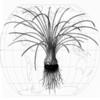| Publication Type: | Journal Article |
| Year of Publication: | 2000 |
| Authors: | C. A. Caplen, Werth C. R. |
| Journal: | Systematic Botany |
| Volume: | 25 |
| Issue: | 2 |
| Pagination: | 260 - 280 |
| Date Published: | 2000/// |
| Abstract: | Isoetes riparia is a complex tetraploid taxon of eastern North America that in its widest sense includes a diversity of morphotypes variously segregated, or included in a single polymorphic species. Although the diploid ancestry of I. riparia has been proposed as I. echinospora x engelmannii, it is uncertain whether this ancestry applies to all elements of the complex, here broadly defined to encompass three segregates of I. riparia and the recently described I. hyemalis (referred to informally as riparia, canadensis, saccharata and hyemalis). To help clarify relationships among these tetraploids, isozyme genotypes for 13 loci coding eight enzymes, were determined for 16 populations representing all four segregates. Duplicate gene expression, evidenced as fixed heterozygosity consistent with allopolyploidy, characterized the tetraploid genotypes of all taxa. Although exhibiting modest to no variation within populations, populations were highly differentiated, most showing a unique combination of alleles for their multilocus genotypes, with the exception of five genetically identical Canadian populations. Ancestry was evaluated through comparison to diploid genotypes previously reported. A quantitative approach was carried out to rank likelihoods for hypothetical ancestral combinations of diploids for each tetraploid population. The ancestry I. echinospora x engelmannii hypothesized for I. riparia was unequivocally supported for the six populations of the most northern segregate, canadensis. Diploid ancestries for the remaining 10 more southern populations were less certain, although the diploid I. mattaponi was implicated as a likely ancestor for most. Most likely ancestry for populations of riparia/saccharata was inferred as I. valida x mattaponi, and for hyemalis as I. mattaponi x flaccida. However, these hypotheses were only slightly more likely than other combinations. UPGMA analysis using Rogers' similarity resulted in three clusters corresponding to canadensis, riparia/saccharata, and hyemalis. However, the hyemalis cluster was weakly associated and was not supported by UPGMA using Nei's identity. These highly variable tetraploid genotypes suggest a complicated evolutionary history for the I. riparia complex that probably involved a combination of diverse ancestry, multiple origins, divergence, and gene silencing. |
| URL: | http://www.scopus.com/inward/record.url?eid=2-s2.0-0034046198&partnerID=40&md5=48c688dd1d8bd2bf3f8bc0a92bc03060 |
